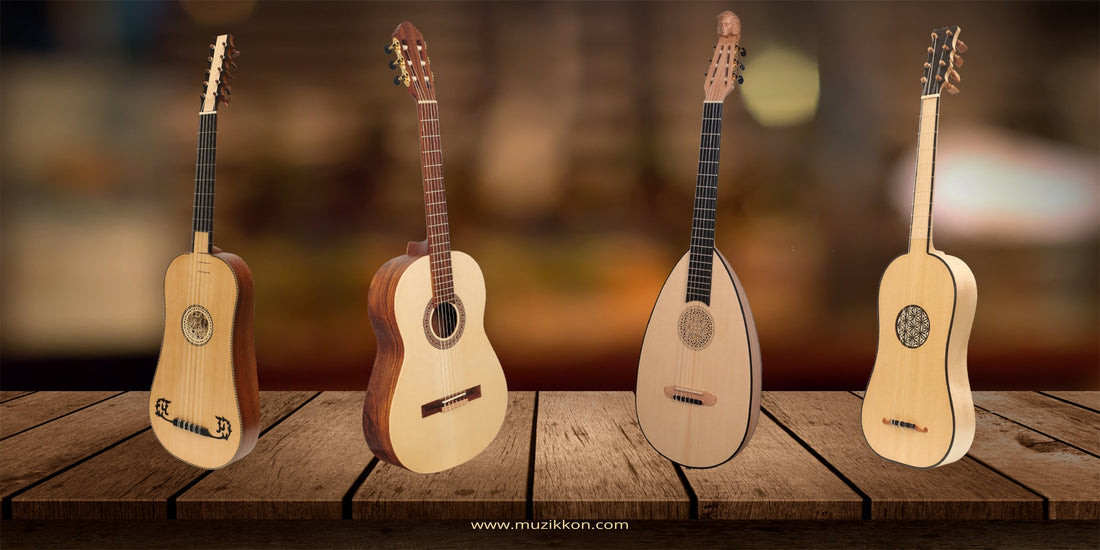Few instruments have traveled a journey as rich and varied as the guitar. Its roots stretch back centuries, yet it continues to shape contemporary music across cultures. The guitar’s story is not only one of changing musical tastes, but also of evolving craftsmanship, regional influences, and technological innovation. From the delicate ornamentation of Baroque guitars to the deep, resonant tones of modern bass guitars, the instrument has transformed while retaining its essential spirit: versatility, portability, and expressive range.
Baroque Beginnings and the Art of Ornamentation

The Baroque period (roughly 1600–1750) brought forward a version of the guitar that was as much a decorative piece as it was a musical tool. Baroque guitars typically featured five courses (pairs of strings) and were used both as solo instruments and for accompaniment. Their sound was light and intimate, ideal for courtly settings and chamber performances.
Luthiers of the time paid special attention to detail. Inlays, rosettes, and sculpted headstocks reflected the aesthetic values of the era. These instruments were tuned differently than modern guitars, often employing re-entrant tuning, which altered the sequence of pitches to support specific harmonic textures. While modern players may find the Baroque guitar’s sound comparatively delicate, its role in shaping early plucked string music is undeniable. You can explore Baroque guitars at Muzikkon’s Collection, where traditional craftsmanship meets historical accuracy.
🔗 Shop Baroque Guitar
The Lute Guitar and the Echo of Renaissance Sound

Closely related to the Baroque guitar is the lute guitar, an instrument that preserves the visual elegance and sonority of the Renaissance lute but with a more guitar-like tuning and feel. The lute guitar emerged as a hybrid, serving those who admired the aesthetic of historical instruments but preferred the playability of a six-string guitar. With its bowl-shaped back and ornate appearance, the lute guitar carries the soul of early European music while allowing for broader accessibility. Muzikkon offers a selection of these instruments in its Lute Guitar Collection, made for both period performers and curious modern players.
🔗 Shop Lute Guitar
From Folk Stages to Parlors: The Rise of the Acoustic Guitar

By the 18th and 19th centuries, the guitar began shifting toward the form we recognize today. The number of strings standardized at six, fan bracing became common, and the body grew larger to increase projection. With the Industrial Revolution, guitars became more affordable and accessible, leading to their popularity among middle-class musicians.
The acoustic guitar came into its own in the 20th century, particularly in blues, folk, and country music. Its voice, shaped by wood type, body size, and string choice, became essential to countless musical genres. From parlors to protest movements, the acoustic guitar served as a companion for personal expression and storytelling. Muzikkon’s Acoustic Guitar Range includes models that reflect traditional design while accommodating the demands of modern performance.
🔗 Shop Acoustic Guitar
Exploring Tone: The Weissenborn and Slide Traditions

slide guitar known for its hollow neck and haunting sustain. Originally developed in the early 20th century, it played a vital role in Hawaiian music before influencing American blues and country genres. The Weissenborn guitar offers a rich tonal palette when played with a steel slide, creating a vocal-like quality that stands apart from fretted instruments.
While not as universally known as standard acoustic or classical guitars, the Weissenborn has a dedicated following among musicians seeking atmospheric textures and resonant slide tones. Muzikkon features handcrafted models in their Weissenborn Guitar Collection, ideal for players who want to explore this unique sound world.
🔗 Shop Weissenborn Guitar
The Bass Guitar and Modern Foundations

The introduction of the electric bass in the 1950s changed the landscape of rhythm and harmony. Although distinct from its earlier guitar ancestors, the bass guitar shares their lineage and continues the story of adaptation and innovation. It fulfilled a need for a compact, easier-to-play alternative to the upright bass, and its presence quickly became essential to rock, jazz, funk, and countless other genres.
Bass guitars focus on low frequencies, underpinning the harmonic structure and driving the groove. Their design has evolved to include multiple pickups, extended ranges, and various body styles to suit both studio and live environments. Today, the bass is not merely a background instrument—it holds its own as a melodic and expressive voice. Muzikkon’s bass guitar selection offers options for new and seasoned players alike.
🔗 Shop Bass Guitar
A Continuing Journey
The guitar’s evolution—from the ornate refinement of Baroque craftsmanship to the raw power of bass lines in modern music—tells a story of cultural exchange, artistic experimentation, and musical necessity. Each type of guitar represents a moment in time, a need, a sound, and a community of players. Whether you're drawn to historical styles or contemporary tones, Muzikkon’s Guitar Collection offers a window into this ongoing journey, inviting musicians of all backgrounds to find their voice.

